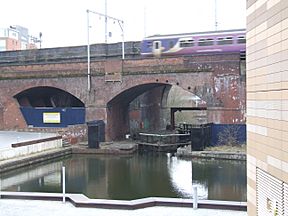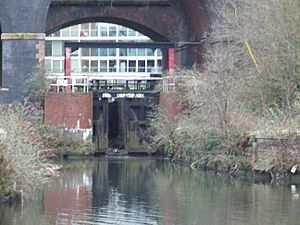Hulme Locks Branch Canal facts for kids
Quick facts for kids Hulme Locks Branch Canal |
|
|---|---|

The Hulme Locks at the Bridgewater Canal end
|
|
| Specifications | |
| Locks | 2 |
| Status | Closed |
| History | |
| Date of first use | 1839 |
| Date closed | 1995 |
| Geography | |
| Connects to | Mersey and Irwell Navigation |
The Hulme Locks Branch Canal is a short waterway in Manchester, England. It's about 200 meters long. This canal was built to connect two important waterways: the Mersey and Irwell Navigation and the Bridgewater Canal. It opened in 1838.
The canal was replaced in 1995 by a new lock at Pomona Dock 3. Today, its locks are closed, and the canal has become overgrown.
Contents
Building the Canal
Before this canal was built, moving goods between the Mersey and Irwell Navigation and the Rochdale Canal was a big problem. Boats couldn't go directly from one to the other. Workers had to unload goods from boats onto carts. Then, they carried the goods across the city. Finally, they loaded them back onto other boats.
This process wasted a lot of time and money. It also made traffic much worse on Manchester's busy streets.
Early Ideas for a Link
In 1799, a company called the Manchester Bolton & Bury Canal (MB&B) suggested a solution. They wanted to build an aqueduct (a bridge for boats) over the Mersey and Irwell Navigation. This would connect their canal to the Rochdale Canal.
However, the Mersey and Irwell Navigation company strongly disagreed. They feared losing business if a direct link was made. So, the idea didn't happen. In 1805, an engineer named John Nightingale looked into the cost of a canal link. But nothing was done until 1836, when John Gilbert became the engineer for the project.
The Hulme Locks Branch Canal is Built
The Bridgewater Canal Company saw that they might lose trade if other canals connected. So, they quickly built the short Hulme Locks Branch Canal. This canal connected their own Bridgewater Canal to the River Irwell.
The very next year, the Mersey and Irwell Navigation company finished their own project. It was called the Manchester and Salford Junction Canal. This new canal offered another way to get from the Rochdale Canal to the River Irwell. This meant boats could now use either the Junction Canal or the Hulme Locks to reach the Irwell.
Why the Canal Closed
The Hulme Locks Branch Canal was built when railways were becoming popular. However, trains didn't immediately stop boats from using the Bridgewater Canal.
Later, the Manchester Ship Canal Company owned both the Bridgewater Canal and the River Irwell. This meant there was no longer a reason for the two waterways to compete. The Junction Canal was closed in 1922.
The Hulme Locks Branch Canal kept operating until 1995. That year, a new lock was opened at Pomona Docks (Dock 3). This new lock made the Hulme Locks Branch Canal unnecessary. Today, the canal is no longer used and has become overgrown.
Changes to the Locks
Originally, the Hulme Locks Branch Canal had three locks. Locks are like water elevators that help boats move between different water levels.
In the 1950s and 60s, the Bridgewater Canal was improved. This was because many barges carried maize (corn) from ships in Salford Docks to the Kellogg's factory in Trafford Park. To help these barges carry more, the three locks were changed into one single, deep lock in 1962. The canal was also made deeper in this area.
A new group of steel barges was built in the late 1940s and early 1950s. These were mainly used for the Kellogg's maize traffic. However, this traffic stopped in 1974. Kellogg's found it hard to find ships small enough to bring maize from Canada through the Ship Canal. So, they built a new factory in Liverpool instead.


